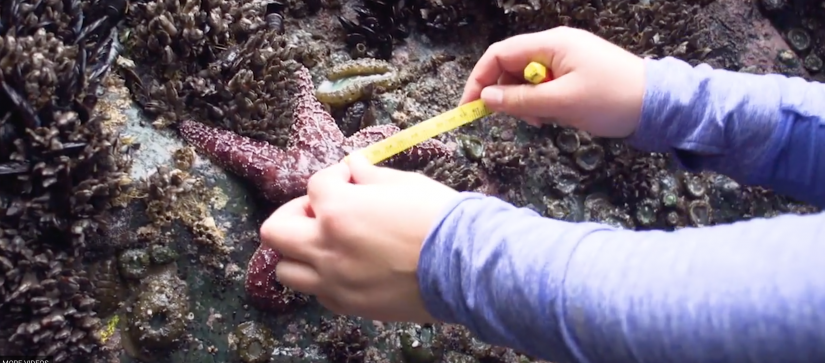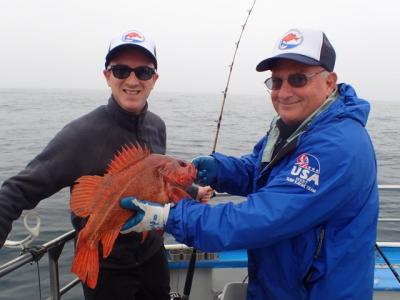Breadcrumb
- Marine Protected Areas
- Research & Monitoring
Research & Monitoring

Are marine protected areas working?
In order to understand whether marine protected areas (MPAs) are doing their job protecting our oceans, we have to monitor them. Just as a doctor may measure your heartbeat or blood pressure, researchers measure ocean chemistry, temperatures and the abundance and locations of different species to determine whether ocean ecosystems are healthy, how they are changing, and how MPAs are working to protect the health of the ocean.
After California established the statewide MPA network in 2012, California Sea Grant partnered with the California Ocean Protection Council and California Department of Fish and Wildlife to administer monitoring project funding for the MPA Monitoring Program. The MPA Monitoring Program includes a two-phased approach to monitoring: Phase 1 – Baseline Monitoring and Phase 2 – Long-term Monitoring.
Phase 1 of the MPA Monitoring Program focused on funding regional baseline monitoring of MPAs. These projects established a benchmark, or characterization of ecological conditions and human activities both inside and outside of MPAs, at or near the time of MPA implementation. This information will help evaluate the effectiveness of the MPAs and the network as a whole meet the goals of the Marine Life Protection Act.
Using Phase 1 baseline monitoring information, as well as novel, quantitative, and expert-informed approaches from baseline monitoring, CDFW and OPC developed the MPA Monitoring Action Plan, which guides next steps for Phase 2 – Long-term Monitoring. The action plan lists key evaluation questions and prioritizes metrics, habitats, sites, and species to target for long-term monitoring in order to inform the evaluation of California’s MPA network. MPA Monitoring Action Plan (CDFW 2018)
The state has now launched long-term monitoring projects that will run from 2019 to 2021. Long-term monitoring will help California evaluate the performance of the network in meeting the goals of MLPA and inform adaptive management. These projects will support up to three years of research across the statewide network. The awards, administered by California Sea Grant, were selected by a panel of experts and guided by the monitoring priorities outlined in the Action Plan. To read about these projects, see the Project Updates below.
Baseline monitoring projects
- MPA Baseline Monitoring Projects: Central Coast (2007-2013)
- MPA Baseline Monitoring Projects: North Central Coast (2010-2016)
- MPA Baseline Monitoring Projects: South Coast (2011-2017)
- MPA Baseline Monitoring Projects: North Coast (2014-2018)
Long-term monitoring projects
- MPA Long-term Monitoring Projects (2019-2021)
Project Updates: Long-term Monitoring Projects
- MPA update: A deep dive into the mid-depth rocky reef
- MPA update: Sport anglers reel in fisheries data
- MPA update: Fishing communities discuss protected areas impacts
- MPA update: Observing the space between land and sea
- MPA update: Monitoring California's iconic kelp forests
- MPA update: Integrating data to assess California's marine protected areas
- MPA update: Sandy beaches and surf zones offer clues to ocean health
Previous and related research
The design of California’s network of marine protected areas was informed by years of scientific research, including science funded and conducted by California Sea Grant. This research was incorporated in the 2008 and 2016 Master Plan for Marine Protected Areas. The 2008 Plan provides the science guidelines for the design process. That information is also found in Appendix A of the 2016 Master Plan.

The program continues to invest in research that augments the monitoring funded by the state, allowing California to gain a better understanding of how our MPAs are working, as well as how outside influences like climate change are affecting ecosystems both inside and outside of MPAs.
Since 2003, California Sea Grant has also invested over $2 million of federal funding in research that has informed and supported California’s network of MPAs. Below are links to recent key research projects.
- Adaptive management of marine protected areas: predicting responses to MPA implementation for comparison to monitoring data
- Effects of marine reserves on behaviorally-mediated changes in spawning success of California sheephead
- Realistic behavioral-physical models of connectivity for a network of marine protected areas
- Insulin-like growth factor I (IGF-I) as a physiological biomarker for growth rate and nutritional status of fishes in Marine Protected Areas (MPAs)
- Species distribution models for management of fisheries and MPAs: innovative approaches to cost-effective data collection in California
- Behavioral-physical regulation of nearshore retention and cross-shelf transport of fish larvae in a network of marine reserves
- Larval connectivity among marine protected areas using robot larvae to simulate depth regulation behaviors of many species
California Sea Grant's team of extension specialists - scientists based in coastal communities from San Diego to Eureka - have also contributed to important research. Read more about the history of California Sea Grant's research and the development of the California MPA system in this interview with former California Sea Grant Extension Director Rick Starr.
- California Seafood Profiles
- Aquaculture in California
- Discover California Commercial Fisheries
- Seaweed Aquaculture
- Kelp
- Coastal Hazards & Resilience
-
Marine Protected Areas
- Outreach Resources
- Reports and Data
- Research & Monitoring
- Red Tides in California
- King Tides
- Rip current safety
- FAQ: California’s Marine Heatwaves
- FAQ: Droughts & California’s Coastal Regions
- Estuaries: Connecting Land to Ocean
- Street Trash Monitoring Protocols and Educational Curriculum
- Safely Viewing Marine Mammals
- Grunion: bridging land and sea
- Delta Smelt
- Recursos en Español